|
|
|
|
|
|
Service history of the RF-84F with the RNLAF
The Republic RF-84F Thunderflash was, in its time, one of the most
extensively used photo-reconnaissance aircraft in NATO. With its robust
construction, ability to withstand heavy stresses, long range and six
exceptional cameras in the nose section it became a popular aircraft
type in several countries.
The American Republic factories started to develop the F-84F
Thunderstreak at the end of 1949. The third prototype YF-84F had the air
intakes placed at the wing root in order to use a new radar system. The
result was a loss of thrust, thus causing a lower performance, so the
project was cancelled. However, the design made sense for a dedicated
reconnaissance platform as the new aircraft permitted a hollowed-out
nose section to be fitted to the aircraft to which camera equipment
could be carried internally - all the while retaining 4 x 0.50 calibre
Browning M2 heavy machines guns for combat purposes.
The resulting aircraft became the "YRF-84F" and this model appeared in
February of 1952 - as the Korean War (1950-1953) was in full swing. The
new aircraft sported the same all-swept-back wing surfaces as the
Thunderstreak production fighters to aid in high-speed flying. The wing
main planes exhibited twin boundary layer fences and blended smoothly
into the wing root intake shrouds. The retractable tricycle
undercarriage of the original was also retained as was the pilot's
placement near the front of the aircraft.
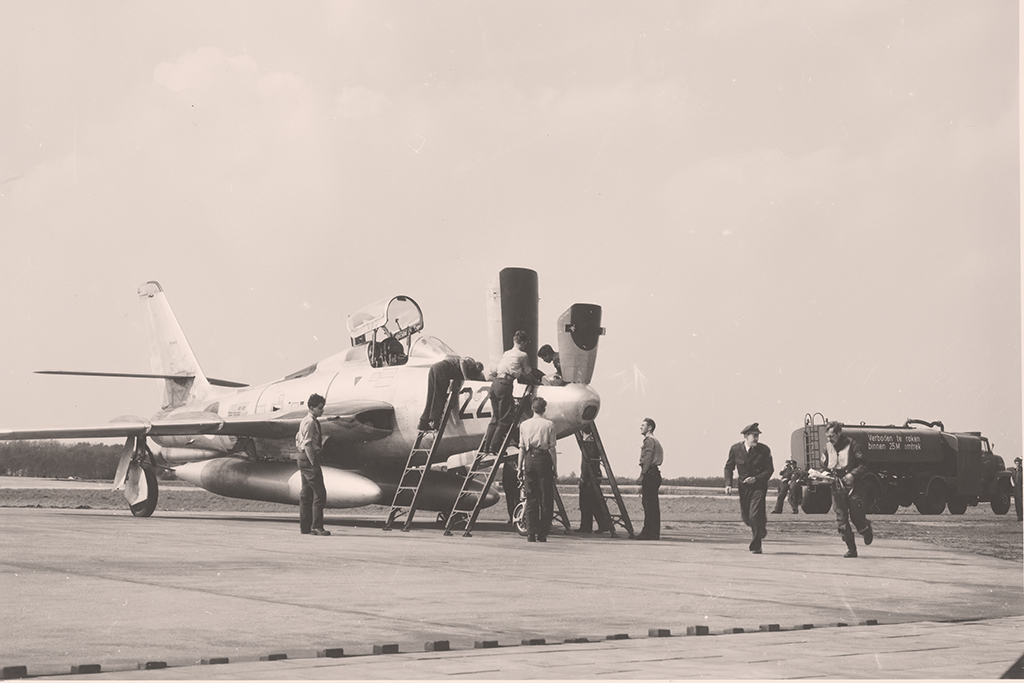
Internally, the camera equipment was assisted through an early-form
digital arrangement to take into account the aircraft's speed and
operating altitude as well as current lighting conditions to provide for
a more accurate picture.
A large amount of different cameras was available, for several heights
and also for day and night.
A maximum of fifteen different types could be used, to know: six forward
looking cameras, one ‘TriMetrogen’ camera, eight ‘oblique’ and vertical
cameras.
These were of the type Fairchild K-17C, K-22 A, KA-2, T-11,
K-38; each could be equipped with lenses varying from 6 to 36 inch. The
Fairchild K-37 night camera to be used with flash-flares had a 12 inch
lens. New at that time was the computerized Tri-Metrogen system, which
modified the camera setting depending of speed, height and brightness.
Innovations included computerized controls which
adjusted camera settings for light, speed, and altitude, a periscope to
give the pilot better visualization of the target, and a voice recorder
to let the pilot narrate his observations.
The nose had several hatches, so vertical and also oblique photos could
be made. These hatches could be operated hydraulically; also a recording
system for the pilot was available. The pilot had also a periscope to
take a vertical look by himself.
In the end, some 715 RF-84F Thunderflash aircraft were built with the
series entering formal service in March of 1954.
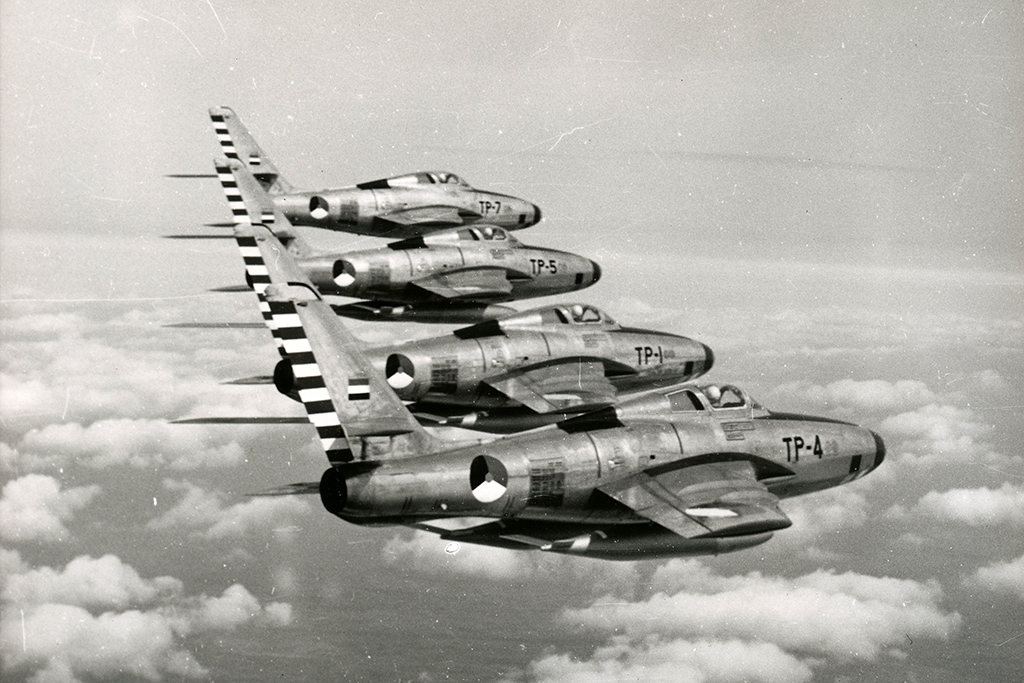
Delivery to the Royal
Netherlands Air Force
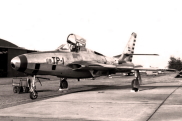 |
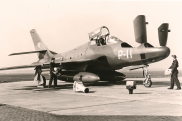 |
|
|
|
|
|
|
As part of the Mutual Defence Assistance Program, the Royal Netherlands
Air Force (KLu) received twenty-four Republic RF-84F Thunderflash. The
largest number where transported by sea between June 1955 and May 1957.
The CVE-58 Corregidor was the first ship to transport Republic RF-84F
Thunderflash to the Netherlands it delivered the P-1 to P-4, P-12 to
P-17, and P-21 to P-24.
The second ship to bring Republic RF-84F Thunderflash to Rotterdam was
the CVU-64 Tripoli. Republic RF-84F Thunderflash brought in by the
Tripoli are the: P-5 to the P-11.
The Republic RF-84F Thunderflash P-19 and P-20 where delivered to
Rotterdam via commercial shipment. The remaining Republic RF-84F
Thunderflash were flown from the United States, via Copenhagen, to the
Netherlands via the so-called 'High-Flight' route.
The first two Republic RF-84F Thunderflash delivered to the Royal
Netherlands Air Force where, the P-7 and the P-8, which were handed over
to 306 Squadron on March 2, 1956. The first eighteen Republic RF-84F
Thunderflash were silver coloured and got the code TP-1 to TP-18. The
remaining aircraft got a P code instead of the TP- code and where
camouflaged.
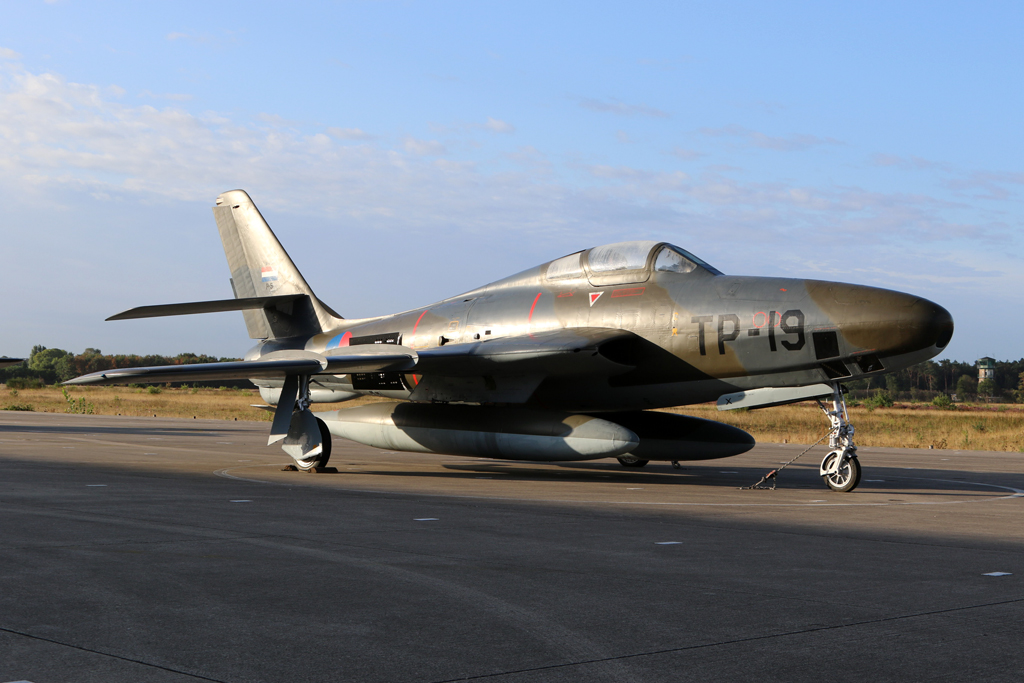
|
|
|
|
|
|
|
In service
|
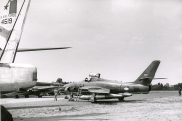 |
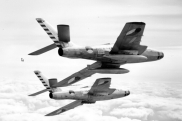 |
|
|
|
|
|
|
Operational history
The first RF-84F Thunderflash went to 306 Squadron to the Royal Netherlands Air Force at Royal Air Force Laarbruch Germany to replace the existing fleet F-84E Thunderjet on 4 April 1956.
The squadron was based at Laarbruch as part of the 34 Recce Wing together with 79 and 541 squadron of the Royal Air Force. In their early days they wore a silver livery with the 306 squadron-code (TP-) on the nose this changed to only the P- code when usage of the squadron-codes system stopped .
In preparation of the new system pilots and technician where trained at the American base of Sembach where the USAF was flying the RF-84F Thunderflash. In 1957 306 squadron moved to Deelen Air base , although the accommodations at Deelen where basic the squadron kept working on the new systems.
In 1958 the Dutch RF-84F Thunderflash participated for the first time in the 'Royal Flush' exercise.
This exercise, in which thirteen NATO countries competed over their photo reconnaissance skills. In the following year, 306 Squadron was already divided first, along with the English Canberras of the 2nd ATAF.
During 1963 the transition to the RF-104G Starfighter started , during this period the last operational RF-84F Thunderflash where moved to Volkel Air Base as the rest of the squadron moved to Twenthe Air base
for the transition to the RF-104G Starfighter.
As the RF-84F Thunderflash of the Royal Netherlands Air Force where
delivered via the Mutual Defence Assistance Program , the United States
Air Force to decided that the remaining aircraft would be delivered to
Turkey and Greece. The first aircraft where transferred to Turkey on
October 17, 1963.
Squadrons equipped with the Republic RF-84F Thunderflash
|
|
306 Squadron Royal Netherlands Air Force Videre vincere est (zien is
overwinnen)
Throughout moost of its existence, 306 Squadron has been the only
photo-reconnaissance unit in the Royal Netherlands Air Force, having
formed at Volkel in September 1953. Its initial equipment consisted of a
dozen aircraft from the first batch of Republic F-84E/G Thunderjet, with
the first F-84G Thunderjet delivered in September 1953. After test in
November 1953 were taken with a K.17 camera in the left tip tank of an
F-84E Thunderjet and proven to be successful. The decision was made to
replace most of the F-84G Thunderjet in 1954 with the modified F-84E
Thunderjet. The first pictures where made with this system May sixth
1954, the K.17 camera would be replaced with the K.20 model for better
results. The different aircraft where coded TP-1 to TP30, TP- being the
code for 306 squadron in the then used unit code system.
In September 1954 the squadron transferred to Laarbruch Airbase Germany
after a seven-week period at Buckeburg Airbase Germany, at that time it
had also become clear that the F-84E Thunderjet became obsolete and had
to be replaced. The replacement came in the form of twenty-four new
Republic RF-84F Thunderflash aircraft coded TP-1 to TP-18 (later P1 to
P24) delivered in the period 1956 to 1958. To prepare for this new
aircraft the squadron received two Lockheed RT-33A Shooting Star photo
reconnaissance aircraft TP-19 and TP-20 (later M-101 and M-102) in
August 1955. The RT-33A Shooting Star had four cameras in the nose,
three K18 and a K22 camera, which was a big improvement over the single
K20 camera of the F-84E Thunderjet.
The squadron was stationed at Laarbruch Airbase from 8 Nov 1954 till 13
Dec 1957 building up its strength on the RF-84F Thunderflash. In their
early days the RF-84F Thunderflash wore a silver livery with the 306
squadron-code (TP-) on the nose this changed as the Royal Netherlands
Air Force adopted an American style of squadron build-up instead of the
English style.
After two years the squadron was fully switched to the RF-84F
Thunderflash and the RT-33A Shooting Stars became redundant. The RF-84F
Thunderflash were mainly used for operational photographs and the RT-33A
Shooting Star mainly for external photo tasks, for example, pictures of
ice or the delta works.
At the end of 1957, when 306 squadron was transferred to Deelen Airbase
in the Netherlands, it was also decided that the squadron would perform
only operational photography. It was at the end of 1958 when a separate
photo section was raised for executing other photography tasks, the Base
Photo Flight Deelen that the RT-33A Shooting Star where transferred to
that unit.
As the squadron moved to Twenthe Airbase to convert to the Lockheed
F-104G Starfighter they were gradually withdrawn during the year. As 306
Squadron was chosen to be the first KLu Lockheed F-104G Starfighter
unit, it found on its arrival at Twenthe that two F-104G Starfighter
aircraft had already been delivered, on 19 December 1962. At the
same time its remaining nine RF-84F Thunderflash moved to Volkel Airbase
to fulfil the reconnaissance tasks until there transfer to other NATO
partners.
.
|
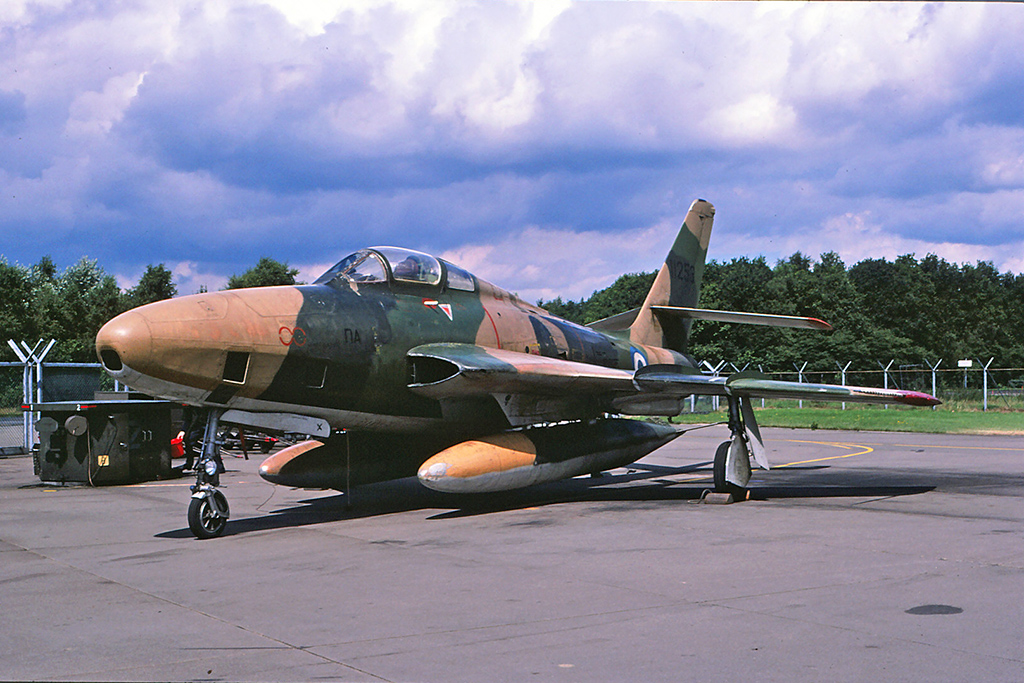 |
|
End of the line
The Netherlands
replaced the RF-84F Thunderflash with the RF-104G Starfighter and the RF-84F
Thunderflash were handed over to Greece and Turkey, leaving not a single
RF-84F Thunderflash in the Netherlands.
As the
last Greek Thunderflash where being withdrawn from use at the end of the
eighties. Efforts where made to get one example back to the Netherlands.
With the involvement of America the plan succeeded and one example landed at Volkel air base on
Friday July 28, 1988.
This RF-84F Thunderflash the 51-11253 flying with 348
MTA (Tactical Reconnaissance Squadron) was one of the former Dutch
Air Force examples delivered to the Greek air force in 1963 ,the P-5.
The aircraft is now on display at the Militaire
Luchtvaartmuseum at Soesterberg.
|
|
Serial |
Type |
US Fiscal Year nr. |
Squadron codes |
Date in service |
Date out of service |
Notes |
|
P-1 |
RF-84F |
51-17001 |
TP-1/ TP-5 |
04-04-1956 |
mrt-63 |
To Greece |
|
P-2 |
RF-84F |
51-11254 |
TP-14 |
18-12-1956 |
13-08-1957 |
Written off |
|
P-3 |
RF-84F |
52-7233 |
TP-7/TP-19 |
20-04-1956 |
17-10-1963 |
To Turkey |
|
P-4 |
RF-84F |
52-7241 |
TP-6 |
16-04-1956 |
17-10-1963 |
To Turkey |
|
P-5 |
RF-84F |
51-11253 |
TP-19 |
11-05-1956 |
mrt-63 |
To Greece |
|
P-6 |
RF-84F |
51-17000 |
TP-8 |
11-05-1956 |
mrt-63 |
To Turkey |
|
P-7 |
RF-84F |
52-7231 |
TP-15 |
02-03-1956 |
17-10-1963 |
To Turkey |
|
P-8 |
RF-84F |
52-7236 |
TP-2 |
02-03-1956 |
17-10-1956 |
To Turkey |
|
P-9 |
RF-84F |
52-7239 |
TP-18 |
16-05-1956 |
03-10-1957 |
Written off |
|
P-10 |
RF-84F |
52-7242 |
TP-4 |
21-03-1956 |
okt-63 |
To Turkey |
|
P-11 |
RF-84F |
52-7284 |
TP-5 |
22-03-1956 |
mrt-63 |
To Turkey |
|
P-12 |
RF-84F |
51-17002 |
TP-3 |
02-03-1956 |
13-10-1958 |
Written off |
|
P-13 |
RF-84F |
52-7243 |
TP-9 /TP-14 |
20-09-1957 |
mrt-63 |
To Turkey |
|
P-14 |
RF-84F |
52-7280 |
TP-10 |
23-10-1956 |
mrt-63 |
To Turkey |
|
P-15 |
RF-84F |
52-7286 |
TP-9 |
25-9-1956 |
mrt-63 |
To Turkey |
|
P-16 |
RF-84F |
52-7296 |
TP-12 |
29-11-1956 |
21-07-1958 |
Written off |
|
P-17 |
RF-84F |
52-7232 |
TP-16 |
11-01-1957 |
08-06-1960 |
Written off |
|
P-18 |
RF-84F |
51-16997 |
TP-13 |
18-12-1956 |
03-06-1958 |
Written off |
|
P-19 |
RF-84F |
52-7444 |
TP-17 |
29-01-1957 |
mrt-63 |
To Turkey |
|
P-20 |
RF-84F |
52-7434 |
TP-11 |
16-11-1956 |
17-10-1963 |
To Turkey |
|
P-21 |
RF-84F |
51-1890 |
TP-3 |
01-12-1958 |
17-10-1963 |
To Turkey |
|
P-22 |
RF-84F |
51-1909 |
TP-13 |
09-12-1958 |
19-04-1960 |
Written off |
|
P-23 |
RF-84F |
51-1910 |
TP-2 |
14-10-1958 |
17-10-1963 |
To Turkey |
|
P-24 |
RF-84F |
51-1924 |
TP-12 |
13-12-1958 |
17-10-1963 |
To Turkey |
|
|
|
|
 |
|
|